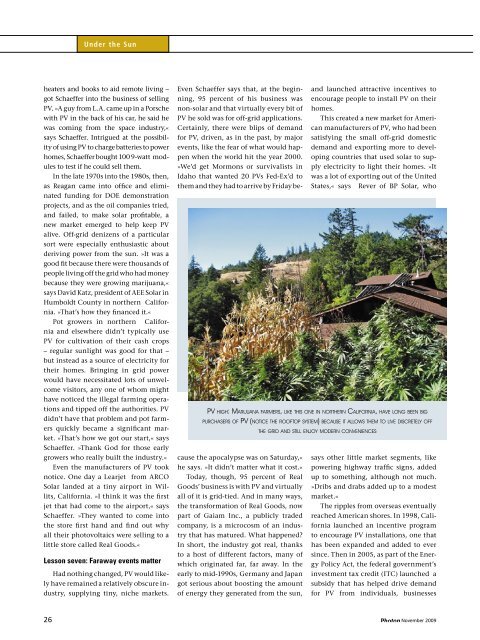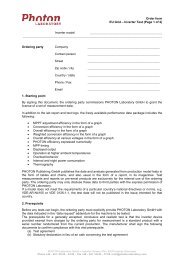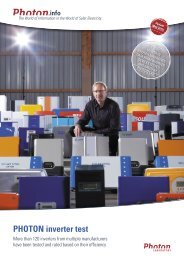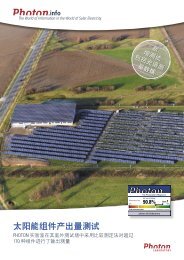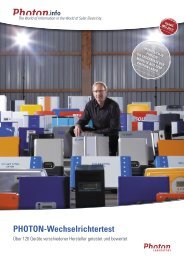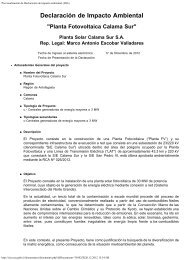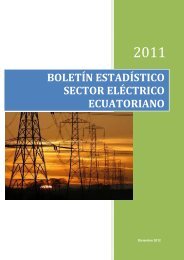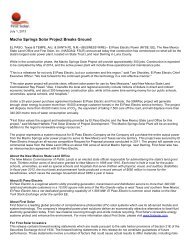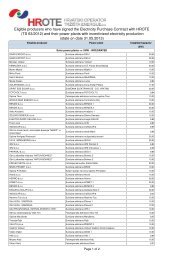INTRODUCTORY SPECIAL INTRODUCTORY ... - PHOTON Info
INTRODUCTORY SPECIAL INTRODUCTORY ... - PHOTON Info
INTRODUCTORY SPECIAL INTRODUCTORY ... - PHOTON Info
Create successful ePaper yourself
Turn your PDF publications into a flip-book with our unique Google optimized e-Paper software.
Under the Sun<br />
heaters and books to aid remote living –<br />
got Schaeffer into the business of selling<br />
PV. »A guy from L.A. came up in a Porsche<br />
with PV in the back of his car, he said he<br />
was coming from the space industry,«<br />
says Schaeffer. Intrigued at the possibil-<br />
ity of using PV to charge batteries to power<br />
homes, Schaeffer bought 100 9-watt mod-<br />
ules to test if he could sell them.<br />
26<br />
In the late 1970s into the 1980s, then,<br />
as Reagan came into office and elimi-<br />
nated funding for DOE demonstration<br />
projects, and as the oil companies tried,<br />
and failed, to make solar profitable, a<br />
new market emerged to help keep PV<br />
alive. Off-grid denizens of a particular<br />
sort were especially enthusiastic about<br />
deriving power from the sun. »It was a<br />
good fit because there were thousands of<br />
people living off the grid who had money<br />
because they were growing marijuana,«<br />
says David Katz, president of AEE Solar in<br />
Humboldt County in northern Califor-<br />
nia. »That’s how they financed it.«<br />
Pot growers in northern Califor-<br />
nia and elsewhere didn’t typically use<br />
PV for cultivation of their cash crops<br />
– regular sunlight was good for that –<br />
but instead as a source of electricity for<br />
their homes. Bringing in grid power<br />
would have necessitated lots of unwel-<br />
come visitors, any one of whom might<br />
have noticed the illegal farming opera-<br />
tions and tipped off the authorities. PV<br />
didn’t have that problem and pot farm-<br />
ers quickly became a significant mar-<br />
ket. »That’s how we got our start,« says<br />
Schaeffer. »Thank God for those early<br />
growers who really built the industry.«<br />
Even the manufacturers of PV took<br />
notice. One day a Learjet from ARCO<br />
Solar landed at a tiny airport in Wil-<br />
lits, California. »I think it was the first<br />
jet that had come to the airport,« says<br />
Schaeffer. »They wanted to come into<br />
the store first hand and find out why<br />
all their photovoltaics were selling to a<br />
little store called Real Goods.«<br />
Lesson seven: Faraway events matter<br />
Had nothing changed, PV would like-<br />
ly have remained a relatively obscure in-<br />
dustry, supplying tiny, niche markets.<br />
Even Schaeffer says that, at the begin-<br />
ning, 95 percent of his business was<br />
non-solar and that virtually every bit of<br />
PV he sold was for off-grid applications.<br />
Certainly, there were blips of demand<br />
for PV, driven, as in the past, by major<br />
events, like the fear of what would hap-<br />
pen when the world hit the year 2000.<br />
»We’d get Mormons or survivalists in<br />
Idaho that wanted 20 PVs Fed-Ex’d to<br />
them and they had to arrive by Friday be-<br />
pV h i g h: mAriJuAnA fArmers, like this o n e in northern cAliforniA, h AV e l o n g been big<br />
purchA sers o f pV (n o t i c e the r o o f t o p system) b e c A u s e it A l l o w s them to liVe discretely o f f<br />
cause the apocalypse was on Saturday,«<br />
he says. »It didn’t matter what it cost.«<br />
Today, though, 95 percent of Real<br />
Goods’ business is with PV and virtually<br />
all of it is grid-tied. And in many ways,<br />
the transformation of Real Goods, now<br />
part of Gaiam Inc., a publicly traded<br />
company, is a microcosm of an indus-<br />
try that has matured. What happened?<br />
In short, the industry got real, thanks<br />
to a host of different factors, many of<br />
which originated far, far away. In the<br />
early to mid-1990s, Germany and Japan<br />
got serious about boosting the amount<br />
of energy they generated from the sun,<br />
and launched attractive incentives to<br />
encourage people to install PV on their<br />
homes.<br />
the g r i d A n d still e n J o y m o d e r n c o n V e n i e n c e s<br />
This created a new market for Ameri-<br />
can manufacturers of PV, who had been<br />
satisfying the small off-grid domestic<br />
demand and exporting more to devel-<br />
oping countries that used solar to sup-<br />
ply electricity to light their homes. »It<br />
was a lot of exporting out of the United<br />
States,« says Rever of BP Solar, who<br />
says other little market segments, like<br />
powering highway traffic signs, added<br />
up to something, although not much.<br />
»Dribs and drabs added up to a modest<br />
market.«<br />
The ripples from overseas eventually<br />
reached American shores. In 1998, Cali-<br />
fornia launched an incentive program<br />
to encourage PV installations, one that<br />
has been expanded and added to ever<br />
since. Then in 2005, as part of the Ener-<br />
gy Policy Act, the federal government’s<br />
investment tax credit (ITC) launched a<br />
subsidy that has helped drive demand<br />
for PV from individuals, businesses<br />
November 2009


